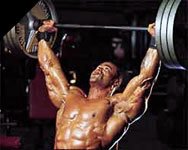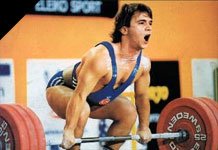With bodybuilding, the overall objective in theory is pretty simple: to increase muscle size through resistance training, diet and supplementation. In practice however this is easier said than done. To gain size there are certain universal truths to be followed.
These truths include the lifting progressively heavier weights and eating high protein diets (fats and carbohydrates are variables to be manipulated depending on the specific goals of the bodybuilder). Rest and positive mental attitude are two other important factors.
What is often not entirely clear is the type and combination of training required to increase muscle growth. The remainder of this article will outline various ways in which to train and provide a rational for each. A key point to remember is that individuals tend to respond to different stresses in different ways.
In other words, what works for one person may not necessarily work for another. So although the actual type of training (meaning the types of exercises and the overall goal of progressive resistance) may not vary from person to person, the number of repetitions, rest between sets, amount of resistance and training tempo may.
The following variables affect every workout (bearing in mind the goal of increased muscle size), so should form the basis of all weight training programs.
Increase Weight (or resistance)
This variable is the only one to overlap into, and is dependant upon, the following six and should therefore be the overall aim of every serious mass-building workout. Increasing resistance is paramount as the muscles will respond to nothing less than the disruption of their very cellular structure. Resistance must be progressive meaning the intensity of the stress on the muscle must increase from workout to workout.
 Classic strongman from the turn of the century Earle E. Liederman said, the weight trainer must work a little harder each session in order to develop the body to its maximum proportions. He went on to say that if this is not done a certain developmental point will be reached and then progress will stand still.
Classic strongman from the turn of the century Earle E. Liederman said, the weight trainer must work a little harder each session in order to develop the body to its maximum proportions. He went on to say that if this is not done a certain developmental point will be reached and then progress will stand still.
Weight can be increased incrementally until a certain number of repetitions are achieved (say 12). Then more weight is added until these 12 repetitions are again achieved. Research has shown that an 8-12 rep range is ideal (Bloofield, Fricker & Fitch, 1992).
Provided adequate rest (8-10 hours sleep and 1-2 days between sessions; Bloomfield, Fricker & Fitch, 1992) is undertaken progress should occur. In saying this, too much time taken off between sessions may deleteriously affect progress. It is a matter of finding out what works best, by monitoring progress, and then balancing rest and training to achieve further results.
Performing More Sets
Increasing the number of sets will increase intensity up to a point. An ideal number of sets seems to be 3 for a small body part and 4-5 for a larger grouping. Increasing sets to 5-6 or more per session will increase intensity by increasing the overall volume of training at this particular time.
Bodybuilders I have spoken to suggest this is effective if a greater degree of rest is taken following a session (an extra day in most cases). It would be suggested a bodybuilder trial a larger number of sets. Closely monitoring results will indicate the viability of such a session.
Occasional long sessions with 6-7 + sets per body part could be looked upon as "shock" sessions to stimulate the muscles in a different way.
Performing More Repetitions
As mentioned, the general consensus seems to suggest that 8-12 repetitions are sufficient to stimulate muscle growth. In terms of increasing intensity adding weight is probably the best idea (Bloomfield, Fricker & Fitch,1992), although increasing reps does increase intensity as well.
Occasionally adding 100 rep sets and 21s (7 half reps (lower part) followed by 7 half reps (upper part) followed by 7 full reps) to a session will increase intensity, but adding weight should be the main goal for most sessions.
Moving The Resistance Slower
Slow training requires the lifter to lift and lower the weight very slowly. Sessions include one set per exercise but this set will take up to 25 seconds to complete. This system of training is very intense by virtue of the difficulty of training and pain associated with its practice.
Studies have shown that slow training had increased strength in one particular group by 50% (Bass, 2001).
Rest Less Between Sets And Exercises
Resting between sets is thought to increase intensity as doing so hastens muscle fatigue. However resting too little will affect the muscles ability to work, thus compromising the quality of the next set. 60 to 90 seconds is thought to be an ideal period of time between sets, as the muscle will have recovered sufficiently by then.
Short rest periods are effective when super setting (one exercise to another with very little rest in between), and when doing drop sets (with same exercise lower the weight and do another set straight away). The intensity gained from these two exercises is productive but one should be cautioned against taking this sort of approach at every session as it could lead to over-training.
Focusing On The Job
 Training focus is a vitally important element in increasing workout intensity. Breaking ones concentration will result in the stress being taken off the muscle and the set will essentially be wasted. The focus should be on stretching and contracting the muscle while ensuring that it does not relax.
Training focus is a vitally important element in increasing workout intensity. Breaking ones concentration will result in the stress being taken off the muscle and the set will essentially be wasted. The focus should be on stretching and contracting the muscle while ensuring that it does not relax.
This leads not only to a greater pump but greater microtrauma of the muscle. Trying to block out all other thoughts when completing a set will assist concentration and allow one to focus on lifting weights with greater intensity.
Variability Of Repetitions
Assisted repetitions by having ones partner help them to achieve a additional one or two reps beyond momentary positive failure, will help to increase intensity. Negative movements will have a similar effect. These can be done with a weight which is about 120% of ones one repetition maximum.
Several eccentric phase (downward) reps are performed while a partner assists. Broken reps can be done with a selected weight that allows for a large number of reps (say 25). A number is chosen (say 100) and the lifter aims for this number in blocks of 25 reps with 25 seconds rest between each set.
Conclusion
The intensity techniques outlined in this article can be used to break the monotony of a stale training program and enhance muscular growth through added intensity. However, the rep variability, slow training, short rest period and high rep methods should not form the basis of a training program.
These can be used sparingly. Anecdotal and scientific research suggest that progressive overload depends primarily on added weight with reps in the 8-12 range. The goal should be to increase weight from session to session.
References
Clarence Bass (2001): Clarence Bass Ripped Enterprises [On line] http://www.cbass.com/index.html.
Bloomfield, J. Fricker, P. A. & Fitch, K.D. (1992): Textbook of Science and Medicine in Sport.
Liederman, E.E.(1900): the golden age of Iron men
Thanks,
